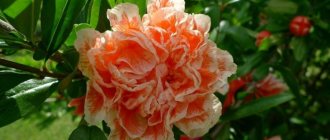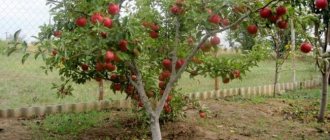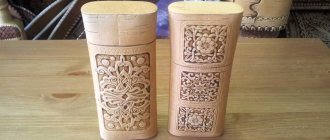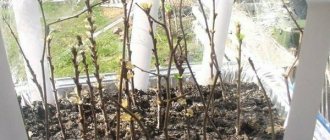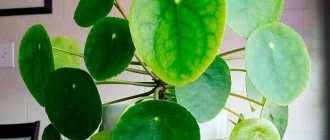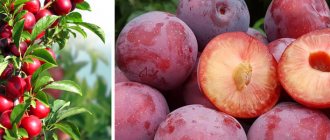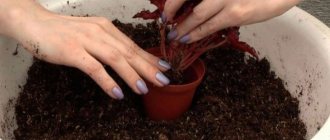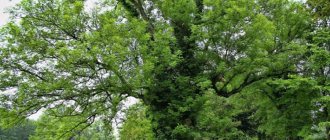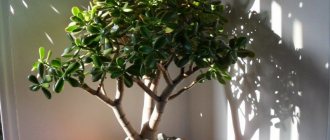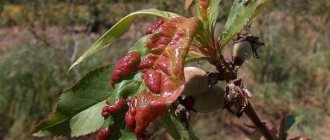Description of the plant
Hornbeam is a deciduous tree from the Birch family. Its height reaches 30 meters, the trunk diameter is small, up to 40 cm. The crown has a cylindrical shape, it is very lush and beautiful.
Depending on the species, the leaves have different lengths - from 5 to 15 cm. Their edges are jagged, the color is rich, dark green. The lower part is covered with villi, and the upper part is covered with thin veins. In autumn the leaves turn yellow, red, orange, burgundy. It looks amazingly beautiful.
In the spring, as soon as the first leaves appear, male and female catkins are formed, which dry up after pollination and subsequently fly off. In their place, fruits are formed - small brown nuts, three to five millimeters in diameter. The hornbeam tree (you can see a photo of it in the article) bears fruit from the age of 15-20 years. Lives for a long time - 300 years.
The root system of the plant is branched and located close to the soil surface. Sometimes the roots are located above the soil level. The trunk is covered with smooth, light-colored bark.
The tree grows slowly, but the process can be accelerated by regular feeding. The plant prefers lime-rich soils and good moisture. The hornbeam tree, the description of which is presented in the article, is characterized as a light-loving, shade-tolerant plant that can withstand strong winds.
Reproduction
Young seedlings are obtained using vegetative techniques and growing them from seeds. The hornbeam tree is propagated in the following ways:
- Seeds. In the autumn, you can select seeds and store planting material for up to 3 years. A month before the planned planting, soak them in water or a damp cloth. Place in a warm place and wait for the first shoots to appear. They should hatch in about two weeks. After the seedlings become 2-3 cm in length, they can be transplanted into a pot until the plant gets stronger. Next, send it to a permanent location. This method is long and does not always end in success.
- Cuttings. Cut a cutting up to 20 cm long from a strong shoot. Disinfect the cut base in potassium permanganate. Place in a container of water and let stand for 2-3 days. Plant in prepared moist soil. Wait for the first few leaves to appear and transplant to a permanent location. This method is the easiest and fastest.
- Layerings. Dig a furrow near the root of the tree. Fertilize them, moisten them and transfer there young shoots from the neighboring hornbeam, on which cuts have been made. The least viable option.
It is recommended to replant the plant no later than a month before the first frost, or in the spring before the first buds appear on the cuttings.
Under natural conditions, the tree reproduces on its own. The wind carries the pollen contained in hornbeam flowers from the male tree to the female tree.
Where does it grow?
The growing area is almost the entire continental part of Europe; here the plant abounds in park areas and forests. The hornbeam tree is widespread in Asia, Iran, Transcaucasia, the Baltic states and countries such as Belarus and Ukraine.
It prefers to live in deciduous forests and is found here in the form of pure stands. In the Caucasus Mountains, hornbeam grows at an altitude of 2000 meters and even higher.
Primorsky hornbeam
This variety of hornbeam is called “heartleaf” because its leaves at the base are shaped like a heart. It grows in height from 10 to 20 meters.
Places of distribution are China, Korea, Japan, the Primorsky Territory of our country, and its southeastern regions. Here the hornbeam prefers to settle at the foot of the mountains at an altitude of 200-300 meters, and in the shade of the second tier of mixed forests. This variety of hornbeam is highly decorative. The tree is beautiful at any time of the year.
Features of cultivation
The tree loves calcareous, loamy, loose, sufficiently moist soils with the addition of humus or humus, but does not tolerate soil with high acidity at all. The plant is characterized by great adaptability to different living conditions.
Feels good both in sunny places and in the shade. Mature trees tolerate drought well, although some leaves may fall off in August.
Young seedlings require regular watering in the absence of rain, so to avoid moisture loss, the soil around the trunks after planting is mulched with compost or wood chips. The trees are very resistant to severe frosts and seedlings are usually not damaged by late spring frosts.
Hornbeam Turchaninov
The tree has a small height - only six meters. Distribution area: mountain forests of China. This species is considered rare, but is famous for its high decorative properties. The hornbeam is decorated with a crown that has a perfectly round shape and leaves with a glossy surface and jagged edges. They change color palette throughout the growing season. It looks very nice. In spring the leaves are bronze, later green, and in autumn yellow-orange with speckles of red.
Virginia hornbeam
This tree is a subspecies of the Carolina Hornbeam. Its habitat is North America and its southeastern regions. The plant is most often found in a bush-like form. Its height reaches four meters, the size of the wide crown is the same.
The named tree is used in landscape design. And this is due to the fact that it grows slowly, so it retains its decorative effect for a long time. In addition, it easily tolerates transplanting and cutting, during which it can be given any shape: square, round, trapezoidal, pyramidal. Hornbeam is used to form decorative hedges, sculptures and even entire paintings.
Rules for creating a hedge
From hornbeam plantings you can create entire hedges, giving them the shape of walls or borders. You can create such a hedge using any type of tree.
Borders are created from short plants that grow no more than 0.5 meters. All dwarf trees have a crown width of no more than 30 cm and require very dense planting. To maintain the beauty of your borders, plants should be trimmed regularly. Such borders are perfect for decorating flower beds and paths. But in this form they will only serve a decorative function. Hornbeam flowers will never bloom on such a tree.
Hedges usually do not reach a height of more than 2 meters. They are used only to zone the area of a garden or plot. Special care from the owner of the site is not required, because pruning is carried out no more than once a year. If you build a fence from this amazing tree, the summer resident will be completely protected from dust and noise. And the aroma of the tree’s flowers will delight the senses of guests and hosts.
Wall-shaped hedges are larger - they reach a height of more than 2 meters. This element is more in demand in parks, alleys and private homes. It is recommended to plant young trees at a distance of at least 30 cm from each other.
Often hornbeams are used to create a living wall around the site. Tall plants are used for this, which require little care and rare pruning. Most often, the common hornbeam is used for this. It has a fairly dense crown and creates an excellent wall.
Photo of a hornbeam hedge
Black hornbeam
This tree is also called “oriental decorative”, as it comes from China and Japan. The habitats are the Caucasus, Crimea, Balkans, Iran and Asia Minor. The lifespan of a slow-growing tree is 100-120 years. This variety of hornbeam has been known in culture since the 18th century, but is currently not widespread.
Wood has high density and hardness. According to the traditions of the peoples of the Caucasus, it is this material that is used to produce cues, which look elegant and very beautiful. The black color of wood is achieved through through dyeing of natural wood. The technology is kept strictly confidential. The method is considered unique, since painted wood does not cause allergic reactions.
The black hornbeam is distinguished by its small height (6-10 meters), as well as its curved trunk. The leaves are two to five centimeters long. Strong shoots are lowered down. The crown has a round or ovoid shape. Flowering occurs in mid-spring, and fruiting occurs in late June or early July. This variety of hornbeam does not grow in wetlands or acidic soil.
Landing
The best time to plant a tree is late September, early October. The principle is the same as with transplantation. You need to get there before the first frost or before the buds appear in the spring. Neighboring plants should be located at a distance of 30-40 cm from each other. The depth of the planting hole is 50-60 cm. 10 liters of water are first poured into the planting hole, after a day you can start planting the tree. Technology:
- Place a layer of humus at the bottom of the hole.
- Fill the next layer with drainage, which will prevent excess moisture from reaching the roots, preventing rotting.
- Place the seedling in a vertical position and sprinkle with soil.
- Compact the soil and water.
- Sprinkle with soil to the base of the seedling, mulch with hay or cover with stones.
- Afterwards, periodically water thoroughly once every 3-4 days for the plant to quickly adapt.
Before the onset of cold weather, it is recommended to protect the seedlings from wind and snow. To do this, put a special bag on them or cover them with burlap and branches. It is necessary to ensure that there are no weeds in the root zone. The first pruning can be done only after 2 years.
Usage
The trunk of a hornbeam tree becomes bent during growth, and therefore it becomes unsuitable for construction. But thanks to its hard, durable wood, this plant has been valuable for a long time. It was used as a raw material for blacksmithing, foundry, and jewelry. When wood burns, no smoke is released, so hornbeam was widely used for baking flour products and making pottery.
Durable hornbeam wood, both in ancient times and today, has been an indispensable raw material for the production of various tools: axes, handles, combs. Currently, it is used to make billiard cues, machines, cutting boards, flooring and many other household items.
But this wood needs additional protection, otherwise its characteristics are quickly lost. The treatment is carried out using chemical means.
Belonging to ornamental trees and shrubs, hornbeam is widely used in various industries:
- In livestock farming, the leaves and shoots of the tree are fed to livestock.
- The bark is used for tanning hides.
- Different parts of the tree are used to extract oil. If it is extracted from leaves, it is a raw material in cosmetology, if from fruits, it is used in the food industry.
- Medicine has not ignored the hornbeam either.
Use of leaves, flowers and fruits
The vegetative parts of the plant (leaves, flowers, fruits) have found application in pharmacology and folk medicine. They contain many useful chemicals:
- aldehydes;
- coumarins;
- essential oils;
- acids (caffeic, ascorbic);
- tannins.
Herbal medicines based on hornbeam leaves and flowers are used to improve blood circulation and relieve diarrhea. Experts in the field of homeopathy recommend drinking them when a brain tumor is detected. To normalize reproduction, a collection of young hornbeam branches is taken.
Essential oils extracted from leaves and hornbeam nuts are used in cosmetology and cooking. Young branches and fresh leaves are used to feed livestock. The tannins released from the bark are necessary in the tanning industry.
Benefits of hornbeam
Its leaves and roots contain large quantities of tannins, ascorbic acid, essential oils, aldehydes, caffeic and gallic acids and much more. The fruits are rich in vegetable fats. All parts of the plant are used to prepare tinctures for various diseases:
- To normalize blood circulation, hornbeam flower infusions help patients.
- The use of young shoots as part of medicinal preparations helps treat infertility and various complications during pregnancy.
- Infusions of the leaves are used to relieve diarrhea.
- The juice is useful as a general tonic, as it contains organic substances and many vitamins.
- Hornbeam has a positive effect on muscle and bone tissue.
- Promotes the restoration of organs after operations and the healing of internal ulcers.
- Products and objects made from hornbeam have a positive effect on vision.
- According to researchers, hornbeam lowers blood pressure.
- Helps get rid of skin diseases.
Diseases and pests
Hornbeam has strong immunity to bacterial and fungal pathogens. During periods of epidemics and excessive spread of pests, it may be susceptible to the following pathologies:
- Heart rot. Diagnosed based on black spots on the bark. They quickly spread throughout the tree. Fungi contribute to the death of hornbeam. To avoid infection, choose dry, moderately lit areas for planting;
- Silkworm caterpillars. Pests intensively eat the green mass of foliage. Young shoots are damaged en masse. Larvae are laid in the bark. For processing, use “Aktara”, “Decis”, “Uppercut”;
- Dry tops. The problem is typical for trees over 60 years old. It manifests itself in desiccation and death of the upper branches.
Popular: Caring for frost-resistant, mountain dwarf pine Pumilio
Interesting Facts
Hornbeam is a tree that with its beauty attracts a person who has the opportunity to observe all the changes in the process of its growth. Here are some facts from the life of a tree:
- Hornbeam nuts are brown in color and have a shiny surface. One kilogram of fruit contains 30-35 thousand nuts.
- People have endowed the hornbeam with miraculous properties. Thus, esotericists believe that the tree influences thoughts and encourages a person to do the right things and actions. To recharge your energy and stay alert for a long time, just lean against the trunk.
- A tree planted in your garden helps to organize your thoughts and concentrate on the main things in life. It is believed that then everything will work out as it should.
- If you constantly wear accessories made from hornbeam wood, the nervous system calms down and a person is not subject to stress and depression. Snow-white products are especially popular; it is believed that their owner is noble and pure.
However, it should be borne in mind that the influence of healing and magical properties on each person is not the same. This is due to the character of people, the goals they set and how to achieve them. In each specific case, the hornbeam has a different effect, according to adherents of tree magic.
Properties and Application
Hornbeam is a sapwood species.
The plant is characterized by fairly dense wood. It is noteworthy that this material is very valuable, despite the fact that it is quite difficult to process. When processing, the main thing is to dry the wood thoroughly and correctly. The raw material has a fibrous structure, and wood that is too dried becomes extremely capricious, so special attention is paid to the drying process in production. In addition, hornbeam is used to decorate parks and gardens . In some cases, it is even grown indoors. Thanks to its slow growth, the plant tolerates cutting perfectly, so it can be “adjusted” to any design.
Hornbeam wood is used to make handles for rakes, hoes and shovels, tool handles and other products. All of them are durable, since hornbeam is very durable. In addition, hornbeam wood is used to make golf clubs, billiard cues and other devices that are regularly subjected to intense loads. Hornbeam is not used only in the construction industry, which is explained by the curvature of its trunk . That is, it is very difficult to make a board from this material and absolutely unprofitable.

